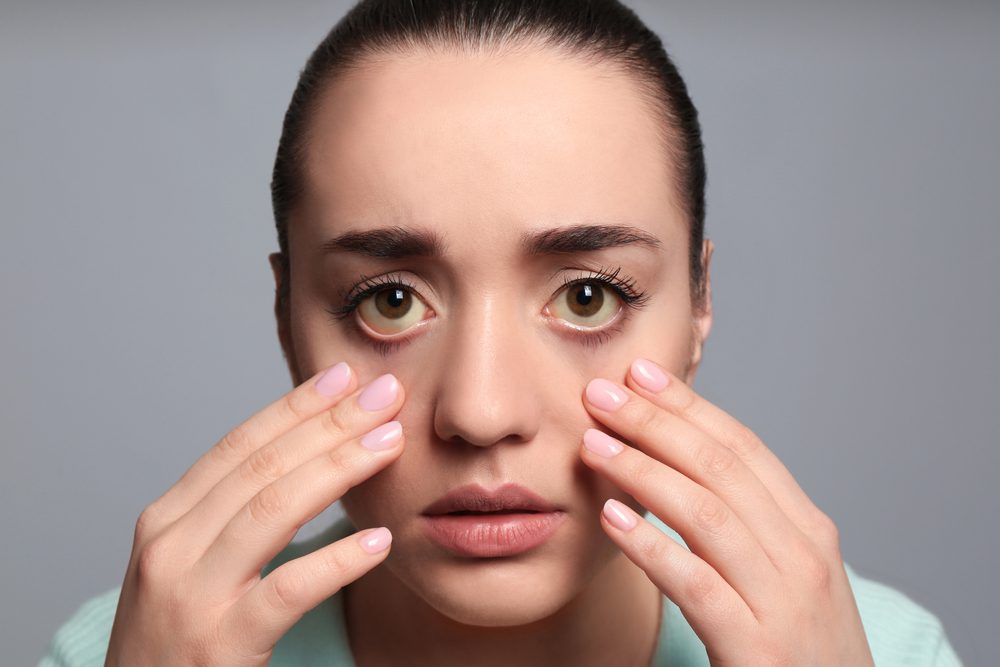Your face is the only area of your body that you view, inspect, and maintain on a daily basis. The face is the most important factor in defining a person’s first impression, as it is the face that tells the full tale of the body.
When a person is sick or unhappy, their face appears weary or despondent. In happy times, on the other hand, it is the face that seems pleased and beaming. As a result, here are some more significant indicators that provide information about your health!
Health Issues Written on Your Face

1. Yellowish Skin and Eyes
This is a case of jaundice. It occurs when your body produces an excessive amount of a waste product as a result of the breakdown of red blood cells. It’s common – and typically harmless – in newborns born before 38 weeks because their livers haven’t matured enough to function properly.
Adults with jaundice may have more serious illnesses, such as viral infections (hepatitis, mononucleosis), liver, gall bladder, pancreatic disorders, or alcoholism.
2. Moles
These are little lumps or patches that are usually dark in color. The majority are harmless, but skin checks can help you detect cancer before it spreads. Remember your ABCDEs when it comes to moles:
Asymmetrical: Is there a difference in the form on either side?
Border: Is it angular?
Color: Is it skewed?
Diameter: Is it larger than a pea?
Evolving: Is it different now than it was a few weeks ago?
If you responded yes to any of these questions, speak with your doctor.
3. Sores
Cold sores are provoked by the type 1 herpes virus, and are most likely to appear around your lips and mouth. (Oral herpes is most commonly contracted by saliva as a kid or young adult, rather than through sexual contact.)
Once you’ve contracted the virus, it’s impossible to get rid of it. When you’re unwell, nervous, or overtired, or if you’ve spent too much time in the sun, sores might appear. They generally go away on their own. However, if you lots of them or experience them frequently, your doctor may prescribe medicine.
4. Cracked Lips
Everyone has chapped or cracked lips now and then, especially in the winter. Balms can help protect and moisturize them. However, dry lips might be an indication of a health problem, such as dehydration, which occurs when your body is dehydrated. They can also be an allergic reaction to medicine, such as steroids, or a response to a drug.
5. Butterfly Rash
Most rashes aren’t significant and go away on their own, but this one is out of the ordinary. It looks like a butterfly on both cheeks and is a frequent symptom of lupus. This is a condition in which your immune system attacks your own tissues and organs.
You may also experience a fever, achy and stiff joints, and bluish fingers in the cold. Consult your doctor if you develop an unexplained rash, especially if it is accompanied by the accompanying symptoms.
6. Hair in Unusual Places
It might simply be a stray hair growing where you don’t want it to — this can happen to males around the ears and brows as they age, and to women around the chin. Facial hair in younger women can be an indication of polycystic ovary syndrome, a disorder that makes it difficult to conceive.
7. Drooping Eyelid
Doctors refer to it as ptosis or blepharoptosis. It can affect one or both eyes, and in extreme situations, your eyelid may get obstructed. You might be born with it or develop it over time. It’s usually innocuous, but it might indicate an issue with your brain, nerves, or eye socket.
Consult your doctor if it happens within a few days or hours, or if you have double vision, weak muscles, difficulty swallowing, or a severe headache – these are all symptoms of a stroke.
8. Can’t Move One Side of Your Face
If you are unable to move a part of your body, get medical help immediately. If you don’t have any other symptoms, it’s most likely Bell’s palsy. It occurs when something, most likely a virus, pushes or swells a nerve that controls muscles in your face.
It commonly manifests itself over hours or days and weakens one side of your face. You can also have discomfort in your jaw and behind your ear. It’s not usually dangerous and goes away in 3 to 6 months.
9. Facial Paralysis with Other Symptoms
A stroke happens when blood supply to a portion of your brain is cut off due to a blood artery rupture or being clogged.
If you detect any of the following symptoms of one, get medical attention immediately: paralysis of the lower half of your face, numbness or weakness in your arms or legs, slurred speech, double vision, dizziness, or difficulty swallowing.
10. Yellow Spots on Your Eyelids
Xanthelasmata are raised yellow pimples on and around your upper and lower eyelids. They’re composed of cholesterol, and while you may not like the way they appear, they’re neither hazardous or painful, and they can typically be removed.
However, they can be an indication that you’re at a higher risk of developing heart disease or having a heart attack, so it’s a good idea to see your doctor for a physical.
11. Puffy Eyes
The region behind your eyes might fill with fluid, giving them a bloated or puffy appearance. Hot, humid weather, as well as a lack of sleep, too much salty food, and hormonal fluctuations, might cause your body to retain extra water.
It happens more frequently as you become older because the muscles that support your eyelids weaken. If your eyes are red and itchy, this might be due to an allergic response to food, pollen, cosmetics, scents, a cleanser, or an infection such as pinkeye.
12. Melasma
This results in gray-brown skin spots on your face. Doctors aren’t sure why it happens, although it might be caused by pregnancy or taking particular birth control drugs. Melasma usually disappears on its own once the baby is delivered or the lady stops taking the medicines.
In certain circumstances, it might linger for several years. However, medications and other treatments, including chemical peels, can be beneficial.
- Read also: 11 Most Common Causes of Glaucoma



















